NEMA connector
NEMA connectors are power plugs and receptacles used for AC mains electricity in North America and other countries that use the standards set by the US National Electrical Manufacturers Association. NEMA wiring devices are made in current ratings from 15 to 60 amperes (A), with voltage ratings from 125 to 600 volts (V). Different combinations of contact blade widths, shapes, orientation, and dimensions create non-interchangeable connectors that are unique for each combination of voltage, electric current carrying capacity, and grounding system.
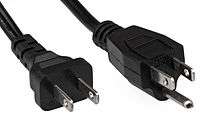


NEMA 1-15P (two-pole, no ground) and NEMA 5-15P (two-pole with ground pin) plugs are used on commonplace domestic electrical equipment, and NEMA 5-15R is the standard 15 A electric receptacle (outlet) found in the United States, and under relevant national standards, in Canada (CSA C22.2 No. 42[1]), Mexico (NMX-J-163-ANCE) and Japan (JIS C 8303).
Other plug and receptacle types are for special purposes or for heavy-duty applications.
The dimensional standard for electrical connectors is ANSI/NEMA WD-6 and is available from the NEMA website.[2]
Nomenclature

Most NEMA connectors are named following a simple alphanumeric code consisting of: a numeral preceding a hyphen, a numeral following the hyphen, and letters at the beginning and end of the code to indicate whether the connector is a locking type and whether it is a plug (male connector) or the corresponding receptacle (female connector).
There are two basic classifications of NEMA connectors: straight-blade and locking. The metal conductive blades are often informally called "prongs" (as in "3-prong plug"). Numbers prefixed by 'L' are curved-blade, twist-locking connectors; others, without a leading 'L', are straight blade and non-locking. Twist-locking types are used for heavy industrial and commercial equipment, where increased protection against accidental disconnection is required.
The numeral preceding the hyphen indicates the type's particular configuration; that is to say the number of poles (current-carrying terminals) and wires connected to it, the voltage meant to be used with, and whether for use with single- or three-phase power. A connector with ground terminal is described as having more wires than poles, e.g. two-pole, three-wire; or four-pole, five-wire; etc. A non-grounding device may be two-pole, two-wire; three-pole, three-wire; etc.
The numeral following the hyphen is the current rating of the device in amperes. This number is followed by the letter 'R' to indicate a receptacle or 'P' to indicate a plug.
As an example, the 5-15R is the common 125 V single-pole, three-wire receptacle rated for 15 A. The L5-15R, while sharing the same electrical rating, is a locking design that is not physically compatible with the straight-blade 5-15 design. The 5-30R has the same single-pole, three-wire configuration and 125 V rating, but is rated for 30 A.
Although there are several non-grounding device types in the NEMA standards, only three of them are in widespread use today. These are the two-pole 1-15, still in use in millions of buildings built before the 1960s, and the three-pole 10-30 and 10-50.
Other types of NEMA connectors that do not follow this nomenclature include: the ML series (so-called "Midget Locking" connectors named for their diminutive size), TT (for connecting travel trailers and other recreational vehicles to external power sources), SS series ("ship-to-shore" connectors for connecting boats to shore power) and the FSL series (used in military and aircraft applications).
The small hole near the end of the power (non-ground) blades of some NEMA plugs is used for convenience in manufacturing; if present, it must be of specified diameter and position.[2] Small specialized padlocks are available to fit these holes, allowing "lockout" of hazardous equipment, by physically preventing insertion of locked plugs into a power receptacle.
The blades of a NEMA connector are identified within the dimensional standard as follows: 'G' identifies the grounding conductor, 'W' identifies the (grounded) neutral conductor, and 'X', 'Y', and 'Z' are the "hot" line conductors. Single-phase connectors have only a single terminal identified as 'X' or two terminals, 'X' and 'Y'. Three-phase connectors will use 'X', 'Y' and 'Z'.[2]
Non-locking connectors
NEMA non-locking connectors all use blades of various flat and folded shapes (except for the round pins used on grounding connectors). The plugs can be detached from the receptacles by pulling back on the plug body. These connector families have been designed so that connectors of differing types cannot be accidentally intermated.
NEMA wall receptacles can be found installed in any orientation. Neither NEMA nor the US National Electrical Code nor the Canadian Electrical Code specify a preferred orientation, but the National Electrical Contractors Association's National Electrical Installation Standards (NECA 130-2010) specify that the preferred location of the ground is on top. When the ground blade of a receptacle is on the bottom, the neutral blade is on the upper left and the hot blade is on the upper right. All descriptions below assume this orientation (i.e. clockwise order is ground, neutral, hot for 120 V receptacle versions; and counter-clockwise for plug versions).
NEMA 1
This "2-prong" design, with two flat parallel non-coplanar blades and slots, is used in most of North America and on the east coast of South America on lamps; consumer electronics such as clocks, radios, and battery chargers; and other double insulated small appliances that don't require grounding (earthing).
All NEMA 1 devices are two-wire non-grounding devices (hot-neutral) rated for 125 V maximum. 1-15P plugs have two parallel flat blades, 1⁄4 inch (6.4 mm) wide, 0.06 inches (1.5 mm) thick, 5⁄8–23⁄32 inch (15.9–18.3 mm) long, and spaced 1⁄2 inch (12.7 mm) apart.
1-15R receptacles have been prohibited in new construction in the United States and Canada since 1962, but remain in many older buildings, and this obsolete design is still available for repair use only. Since January 1, 1974, all new power outlets are required to have a ground connection, using grounded receptacles (typically 5-15R or 5-20R) that accept both grounded and non-grounded plugs.[3] Replacement of obsolete NEMA 1 receptacles requires either rewiring with an additional ground conductor for a NEMA 5 receptacle, or a NEMA 5 receptacle complete with a ground fault circuit interrupter for two-wire non-grounded configurations (when a ground conductor is not available).
Ungrounded NEMA 1 plugs are still popularly used by manufacturers of small appliances and electronic devices because of the design's low cost and compact size, and they are upward compatible with modern grounded NEMA 5 receptacles. Standards permit ungrounded plugs where the appliance does not require grounding due to low risk of leakage current, such as on double-insulated devices.
In older plug designs both blades were the same width, so the plug could be inserted into the receptacle either way around. Many plugs manufactured since 1948 are polarized; the neutral blade is 5⁄16 in or 7.9 mm wide, 1⁄16 in or 1.6 mm wider than the line blade, so the plug can be inserted only one way. Polarized 1-15P plugs will not fit into unpolarized receptacles, which possess only narrow slots. Polarized 1-15P plugs will fit 5-15R grounded receptacles, which have the same wider slot for the neutral blade. Some devices that do not distinguish between neutral and line, such as internally isolated AC adapters, are still produced with unpolarized narrow blades. Cheater plug adapters allow a "3-prong" grounded 5-15P plug to be mated to a non-grounded 1-15R receptacle. The adapters include a spade lug to allow connecting to ground, often via the cover screw used to attach the outlet faceplate. These adapters are illegal in some jurisdictions, in particular throughout Canada.[4]
The Japanese plug and socket with narrow faces appear and works physically identical to NEMA 1-15, and such non-grounded receptacles are still common in Japan (though grounded 5-15R and 5-20R receptacles are slowly becoming more common). The Japanese system incorporates stricter dimensional requirements for the plug housing, different marking requirements, and mandatory testing and approval by METI or JIS.[5]
NEMA standards exist for 1-15P, 1-20P and 1-30P plugs, and the 1-15R receptacle. There are no 1-20R and 1-30R receptacles, because 1-20P and 1-30P can mate with a corresponding NEMA 5 receptacle.
 A non-polarized 1-15P plug has 2 identical blades.
A non-polarized 1-15P plug has 2 identical blades.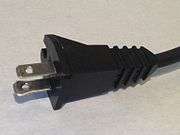 One blade is wider on a polarized 1-15P plug.
One blade is wider on a polarized 1-15P plug. AC adapter with integrated plug pins matching an unpolarized NEMA 1-15P
AC adapter with integrated plug pins matching an unpolarized NEMA 1-15P Newer NEMA 1-15 plugs with wider faces (middle) have a safety advantage; plugs for electric toys (right) have noticeably wide faces.
Newer NEMA 1-15 plugs with wider faces (middle) have a safety advantage; plugs for electric toys (right) have noticeably wide faces.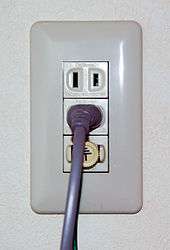 Japanese socket with grounding post, for a washing machine
Japanese socket with grounding post, for a washing machine Japanese socket having the narrowest socket face with grounding post, for an air conditioner
Japanese socket having the narrowest socket face with grounding post, for an air conditioner
NEMA 2
All NEMA 2 devices are two-wire non-grounding devices (hot-hot) rated for 250 V maximum. Although standards exist for 2-15, 2-20 and 2-30, this series is obsolete, and only Hubbell still manufactures 2-20 devices (for repair purposes).[6]
NEMA 3
This series of devices is specified for 277-volt, two-wire, non-grounding devices. According to NEMA, this is "reserved for future configurations," so no designs for this series exist and no devices have been manufactured.
NEMA 4
This series of devices is specified for 600-volt, two-wire, non-grounding devices. Identically to the NEMA 3 series, this is "reserved for future configurations" and no designs for this series exist and no devices have been manufactured.
NEMA 5
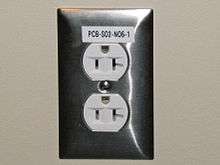

All NEMA 5 devices are three-wire grounding devices (hot-neutral-ground) rated for 125 V maximum, with the 5-15, 5-20 and 5-30 being grounded versions of the 1-15, 1-20 and 1-30, respectively. The addition is a 3⁄16-inch (4.8 mm) diameter round or U-shaped ground pin, 1⁄8 in (3.2 mm) longer than the power blades (so the device is grounded before the power is connected) and located from them by 1⁄4 in (6.4 mm) edge-to-edge or 15⁄32 in (11.9 mm) center-to-center.
Compared to the 5-15P plug, the 5-20P plug has the neutral blade rotated 90° and shifted so its inner edge is approximately 1⁄2 in (12.7 mm) from the hot blade. The 5-20R receptacle has a T-shaped neutral hole, to accept both 5-15P and 5-20P plugs. An acceptable alternative version of the 5-20R receptacle has a rectangular slot that will only accept 5-20P plugs. The 5-30 and 5-50 are physically larger, with 1 in (25.4 mm) between power pins; 5-30 also has an L-shaped neutral blade.[7] These larger sizes are uncommon, as twist-locking plugs are generally used for high-current applications.
The neutral blade on 5-15P plugs is not always wider than the line blade, since the ground pin enforces polarity.
The Electrical Safety Foundation International has stated:[8] "Never remove the ground pin (the third prong) to make a three-prong plug fit a two-prong outlet." In addition to the obvious dangers of breaking a ground connection, removing the ground pin to make it fit a 1-15R receptacle or extension cord, may result in the line/neutral polarity being lost.
The 5-15R and 5-20R are by far the most common electrical receptacle in North America in buildings built since the mid-twentieth century. It is usually installed in a duplex configuration; two receptacles may share a common circuit or may each be wired separately, sometimes to a switch.
In 46 of the 50 United States[9] and all of Canada, tamper-resistant receptacles are required in new residential construction as of November 2013. These prevent contact by objects like keys or paper clips inserted into the socket.[10] This is accomplished by an interlocking mechanism that requires hot and neutral blades inserted simultaneously to release the small doors blocking the slots. The grounding slot is not blocked by a door.
In stage lighting for film and theater, this connector is sometimes informally known as PBG (Parallel Blade with Ground), U-ground, Edison or Hubbell, the name of a common manufacturer.[11] (The name "Hubbell" can be confusing as several different connectors share this name depending on the company, industry, and use.) In the motion picture and TV production industries, an extension cord that uses this type of connector (usually with 12 AWG or 10 AWG wire)[12] is called a "stinger". Generally, lighting technicians use these extension cords to deliver power to lights rated at 2000 W or less.[13]
Internationally, the NEMA 5-15P plug and NEMA 5-15R receptacle are the basis for the International Electrotechnical Commission's IEC 60906-2 standard IEC system of plugs and sockets-outlets for household and similar purposes - Part 2: Plugs and socket-outlets 15 A 125 V a.c. and 20 A 125 V a.c.[14]
NEMA 6
All NEMA 6 devices are three-wire grounding devices (hot-hot-ground) used for 208 and 240 V circuits and rated for 250 V maximum, with the 6-15, 6-20 and 6-30 being grounding versions of the 2-15, 2-20 and 2-30, respectively. The 6-15 resembles the 5-15, but with collinear horizontal pins, spaced 23⁄32 in (18.3 mm) center-to-center. The 20 A plug has a blade rotated 90°, and the 6-20R receptacle may have a T-shaped hole, to accept both 6-15P and 6-20P plugs (similar to the 5-20R receptacle accepting 5-15P and 5-20P plugs).
6-15R and 6-20R receptacles are usually manufactured on the same assembly line as "Industrial" or "Commercial" grade 5-15R and 5-20R receptacles, with all 4 receptacles sharing the same "triple wipe" T contacts behind the varying faceplates. The faceplate bonded onto the receptacle determines the final configuration of the receptacle.
The 30 A plug and receptacle look similar to the 15 A one but larger. The higher-current versions are rare, with twist-locking plugs such as L6-30 or direct wiring more common. Generally 6-series non-locking plugs are used for such appliances as large room air conditioners, commercial kitchen equipment, and the occasional home arc welder. Single-phase 6-50 is commonly used on farms for silo unloaders, and is used with a 6-gauge flexible power cord up to 200 ft (61 m) long. The 6-50 is also used on arc welders.[15] Some manufacturers of electric vehicle charging stations equip their 30-40 A Level 2 EVSEs with a 6-50 plug on a short cord, though it is becoming less common, with manufacturers now favoring the more common 14-50 plug.
NEMA 6 devices, while specified as 250 V, may be used for either 208 or 240 V circuits, generally depending on whether the building has a three-phase or split-phase power supply, respectively. The NEMA 6-20R or 6-30R found in many hotel and motel rooms is typically supplied with either split-phase or two phases of three-phase 208 V.
 NEMA 6-15 (Green "U"-shaped contact is ground.)
NEMA 6-15 (Green "U"-shaped contact is ground.)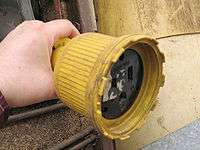 NEMA 6-50 with dustproof flexible shroud, used on a farm silo unloader
NEMA 6-50 with dustproof flexible shroud, used on a farm silo unloader
NEMA 7
NEMA 7 devices are 2-pole and ground connectors rated at 277 V. The 15 A 7-15 plug has the crowsfoot current carrying pins of the Type I plug, but with a U-shaped earth pin. The 7-20 version has an enlarged line/hot pin. 7-30 is a larger diameter connector, with an L-shaped neutral, while the 7-50 has an enlarged neutral pin, compared with the hot.
NEMA 8
NEMA 8 devices are specified for three-wire, two-pole, grounding devices for 480 volts. According to NEMA, this is "reserved for future configurations," so no designs for this series exist and no devices have been manufactured.
NEMA 9
NEMA 9 devices are specified for three-wire, two-pole, grounding devices for 600 volts. According to NEMA, this is "reserved for future configurations," so no designs for this series exist and no devices have been manufactured.
NEMA 10
NEMA 10 connectors are a now deprecated type that had formerly been popular in the United States for use with high-wattage electric clothes dryers, kitchen ranges, and other high-power equipment. NEMA 14-30R and -50R connectors have generally replaced NEMA 10 equipment for these applications. NEMA 10s are classified as 125/250 V non-grounding (hot-hot-neutral), and were designed to be used in a manner that indirectly grounds the appliance frame, though not in the manner consistent with most modern practice. The older practice was common before the requirement of a separate safety ground was incorporated in the National Electrical Code.
As commonly used, 10-30 and 10-50 plugs required the frame of the appliance to be indirectly grounded via a strap connecting to the neutral blade. Safe operation relied on the neutral conductor in turn being connected to system ground at the circuit breaker or fuse box. If the neutral conductor were to break, disconnect, or develop high resistance, the appliance frame could become energized to dangerous voltages. Modern practice is to require a separate safety grounding conductor whose only purpose is to divert unsafe voltages, and which does not carry significant current during normal operation.
Relying on the neutral conductor was a legal grounding method for electric ranges and clothes dryers, under the National Electrical Code from the 1947 to the 1996 editions. Since North American dryers and ranges have certain components (timers, lights, fans, etc.) that run on 120 V, this means that the neutral wire indirectly used for grounding would also carry current, even under non-fault conditions. Although this is contrary to modern grounding practice, such "grandfathered" installations remain common in older homes in the United States.[16]
NEMA 11
NEMA 11 series devices are three-wire, three-pole, non-grounding devices for 3 phase 250 volt equipment and designs for 20 amp (11-20), 30 amp (11-30), and 50 amp (11-50) parts are specified by NEMA.
NEMA 12
NEMA 12 series devices are three-wire, three-pole, non-grounding devices for 3 phase, 480 volt equipment. According to NEMA, this is "reserved for future configurations," so no designs for this series exist and no devices have been manufactured.
NEMA 13
NEMA 13 series devices are three-wire, three-pole, non-grounding devices for 3 phase, 600 volt equipment. According to NEMA, this is "reserved for future configurations," so no designs for this series exist and no devices have been manufactured.
NEMA 14
The NEMA 14 devices are four-wire grounding devices (hot-hot-neutral-ground) available in ratings from 15 to 60 A. The voltage rating is 250 V. Of the straight-blade NEMA 14 devices, only the 14-30 and 14-50 are in common use. The 14-30 is used for electric clothes dryers, the 14-50 is used for electric cooking ranges, and either may also be used for home charging of electric vehicles. The NEMA 14 connectors are essentially the replacements for the older NEMA 10 connectors described above, but with the addition of a dedicated grounding connection.
All NEMA 14 devices offer two hots, a neutral, and a ground, allowing for both 120 and 240 V when supplied by split-phase power, or 120 and 208 V if the supply is three-phase. The 14-30 has a rating of 30 A, and an L-shaped neutral blade. The 14-50 has a rating of 50 A, and a straight neutral blade sized so that it does not mate with 14-30 connectors.
NEMA 14-50 devices are frequently found in RV parks, since they are used for "shore power" connections of larger recreational vehicles. Also, it was formerly common to connect mobile homes to utility power via a 14-50 device. Newer applications include Tesla's Mobile Connector for vehicle charging, which formerly recommended the installation of a 14-50 receptacle for home use.[17]
 NEMA 14-30 and 14-50 receptacles
NEMA 14-30 and 14-50 receptacles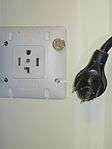 NEMA 14-30 clothes dryer receptacle and plug
NEMA 14-30 clothes dryer receptacle and plug
NEMA 15
NEMA 15 connectors are similar in size and appearance to the 14-series, however they are meant for use with three-phase power up to 250 V, with no neutral conductor (hot-hot-hot-ground).
NEMA 16
NEMA 16 series devices are specified for three-pole, four-wire grounding devices for 3 phase 480 volts. According to NEMA, NEMA 16 straight-blade devices are "reserved for future configurations," so no designs for this series exist and no devices have been manufactured. There are however NEMA L16 series locking devices specified and available for these applications.
NEMA 17
NEMA 17 series devices are specified for three-pole, four-wire grounding devices for 3 phase 600 volts. According to NEMA, NEMA 17 straight-blade devices are "reserved for future configurations," so no designs for this series exist and no devices have been manufactured. There are however NEMA L17 series locking devices specified and available for these applications.
NEMA 18
NEMA 18 connectors are similar to 14 and 15-series devices, but for 120Y208 V three-phase with no ground conductor (hot-hot-hot-neutral).
NEMA 19
NEMA 19 series devices are specified for 277/480Y three-pole, four-wire, non-grounding devices. According to NEMA, this is "reserved for future configurations," so no designs for this series exist and no devices have been manufactured.
NEMA 20
NEMA 20 series devices are specified for 347/600Y three-pole, four-wire, non-grounding devices. According to NEMA, this is "reserved for future configurations," so no designs for this series exist and no devices have been manufactured.
NEMA 21
NEMA 21 series devices are specified for three-pole plus neutral, five-wire grounding devices for 3 phase 120/208Y supplies. According to NEMA, NEMA 21 straight-blade devices are "reserved for future configurations," so no designs for this series exist and no devices have been manufactured. There are however NEMA L21 series locking devices for 20 and 30 amp devices specified and available for these applications.
NEMA 22
NEMA 22 series devices are specified for three-pole plus neutral, five-wire grounding devices for 3 phase 277/480Y supplies. According to NEMA, NEMA 22 straight-blade devices are "reserved for future configurations," so no designs for this series exist and no devices have been manufactured. There are however NEMA L22 series locking devices for 20 and 30 amp devices specified and available for these applications.
NEMA 23
NEMA 23 series devices are specified for three-pole plus neutral, five-wire grounding devices for 3 phase 347/600Y supplies. According to NEMA, NEMA 23 straight-blade devices are "reserved for future configurations," so no designs for this series exist and no devices have been manufactured. There are however NEMA L23 series locking devices for 20 and 30 amp devices specified and available for these applications.
NEMA 24
NEMA 24 connectors are two-pole and ground connectors for 347 V applications. These connectors are almost entirely confined to use in Canada, where 347Y600 V three-phase power is commonly available in commercial buildings and 347 V (single-phase) is used in lighting circuits.
NEMA TT-30

The NEMA TT-30 (TT stands for Travel Trailer) connector is a 120 V 30 A recreational vehicle standard (hot-neutral-ground), also known as RV 30. The TT-30R receptacle is commonly available in nearly all RV parks in the United States and Canada, and all but the largest RVs manufactured since the 1970s use this plug to connect to power feeds.
The appearance of this plug is sometimes confused with a NEMA 10 connector, rated for 240 V, but the NEMA TT-30 is a 120 V device. The hot and neutral blades are angled at 45° from vertical and 90° to each other, unlike NEMA 10 devices (where the angles are 30° and 60° respectively), also the plug is slightly smaller than a NEMA 10 and larger than ordinary 5-15P plugs. The ground pin is round, like those on straight-blade NEMA grounding devices. Referring to the picture, the orientation is the same as the NEMA 5 plug and receptacle, with the neutral blade on the lower right.
Adapters are available with the TT-30P plug on one side and a 5-15R or 5-20R receptacle on the other side. When a power feed cord is detachable from an RV, an L5-30P is usually used on the RV end of the cord.
Twist-locking connectors
Twist-locking connectors were first invented by Harvey Hubbell III in 1938 and "Twist-Lock" remains a registered trademark of Hubbell Incorporated,[18][19] although the term is used generically to refer to NEMA locking connectors manufactured by any company. Locking connectors use curved blades. Once pushed into the receptacle, the plug is twisted and its now-rotated blades latch into the receptacle. To unlatch the plug, the rotation is reversed. The locking coupling makes for a more reliable connection in commercial and industrial settings, where vibration or incidental impact could disconnect a non-locking connector.
Locking connectors come in a variety of standardized configurations that follow the same general naming scheme except that the designations include an "L" for "locking". Locking connectors are designed so that different voltages and current ratings can not be accidentally intermated.[20] Many specific types exist; only a few are listed below. Other types include special purpose connectors for boats, 400 Hz circuits such as used for aircraft, and direct-current applications.
One apparent disadvantage of twist-lock connectors is that in the event that the cable is accidentally pulled too hard, rather than the plug falling out of the receptacle, exposed conductors may come out of the plug, causing dangerous shorts or shock hazards if the circuit is live. This is resolved in most cases by the connector having a robust integral strain relief.
ML
ML-series "Midget Locking" connectors are for 15 A applications where a larger locking connector would not fit. [21]
- ML-1 connectors are two-pole, no ground, rated for 125 V.
- ML-2 connectors are two-pole with ground, rated for 125 V.
- ML-3 connectors are for three-pole no ground (hot-neutral-hot) rated for 125/250 V.
NEMA L1
NEMA L1 series devices are single-pole plus neutral, two-wire, non-grounding devices for 125 volts single phase. Designs and devices for 15 amp devices (L1-15) exist.
NEMA L2
NEMA L2 series devices are two-pole, two-wire, non-grounding devices for 250 volts single-phase. Designs and devices for 20 amp devices (L2-20) exist.
NEMA L3 and L4
These devices would have been for 277 and 600 volt two-pole, two-wire non-grounding devices similar to the straight-blade NEMA 3 and 4 families, but were never specified by NEMA.
NEMA L5
NEMA L5 connectors are a series of two-pole and ground locking connectors rated for 125 V. L5-30R receptacles are common at marinas that provide power to docked boats. They are also found on some RVs for connecting to shore power. RVs in the US are equipped for 120 V 30 A or 240 V 50 A service, and use a cord to connect to a receptacle at the campsite, usually on a power pedestal with one or more receptacles providing 120 V 30 A (TT30R), 240 V 50 A (14-50R), or 120 V 15/20 A (5-20R) service. Locking receptacles appropriate for the voltage and current are used on the RV end of the cord, along with non-locking plugs on the end connecting to the pedestal.
NEMA L6
NEMA L6 connectors are rated for a maximum of 250 volts. They are intended for two-pole, three wire, line-line-earth (or hot-hot-ground) circuits with a nominal supply voltage of 208 or 240 volts, depending on phase configuration. The L6 connector does not provide a neutral connection.
L6-20 connectors provide a maximum of 20 amps and are commonly found in power distribution units (PDUs) used in the information technology sector. Most often, these connectors can be found in server rooms and data centers where the connectors are used to power equipment such as servers, backup systems and UPS units.
L6-30 connectors provide a maximum of 30 amps and tend to be used in heavy-industry sectors. For example, welders and other manufacturing machinery where industrial equipment or large power tools are commonplace.
NEMA L7
NEMA L7 are two-pole and ground connectors rated for 277 V. Typically, these connectors are found in commercial or industrial lighting circuits, especially where metal halide lamps are common.
NEMA L8
NEMA L8 are two-pole and ground connectors rated for 480 V. Intended for three-wire hot-hot-ground circuits.
NEMA L9
NEMA L9 are two-pole and ground connectors rated for 600 V. Intended for three-wire hot-hot-ground circuits.
NEMA L10
NEMA L10 series devices are two-pole plus neutral, three-wire, non-grounding devices for 125/250 volts single-phase. These are deprecated due to the lack of grounding but L10-20 and L10-30 devices are specified by NEMA and are commercially available.
NEMA L11
NEMA L11 series devices are three-pole, three-wire, non-grounding devices for three-phase 250 volt devices. Designs exist for 15 amp (L11-15), 20 amp (L11-20), and 30 amp (L11-30) devices, and L11-20 and L11-30 devices were commercially available from at least one manufacturer (Bryant Electric).
NEMA L12
NEMA L12 series devices are three-pole, three-wire, non-grounding devices for three-phase 480 volt devices. Designs exist for 20 amp (L12-20), and 30 amp (L12-30) devices, and L12-20 and L12-30 devices were commercially available from at least one manufacturer (Bryant Electric).
NEMA L13
NEMA L13 series devices are three-pole, three-wire, non-grounding devices for three-phase 600 volt devices. Designs exist for 30 amp (L13-30) devices and L13-30 devices were commercially available from at least one manufacturer (Bryant Electric).
NEMA L14
NEMA L14 are three-pole and ground connectors rated for 125/250 V. Intended for three-pole, four-wire hot-hot-neutral-ground circuits with a nominal supply voltages of 240 or 208 V hot-to-hot and 120 V hot-to-neutral.
These connectors are common on household backup generators, and on racks of power amplifiers in large audio systems.
NEMA L15
NEMA L15 are three-pole and ground connectors rated for 250 V. Intended for three-phase circuits.
NEMA L16
NEMA L16 are three-pole and ground connectors rated for 480 V. Intended for three-phase circuits.
NEMA L17
NEMA L17 are three-pole and ground connectors rated for 600 V. Intended for three-phase circuits.
NEMA L18
NEMA L18 are four-pole no ground connectors rated for 120/208 V. Intended for wye three-phase circuits.
NEMA L19
NEMA L19 series devices are three-pole, four-wire, non-grounding devices for three-phase 277/480 volt devices. Designs exist for 20 amp (L19-20), and 30 amp (L19-30) devices, and L19-20 and L19-30 devices were commercially available from at least one manufacturer (Bryant Electric).
NEMA L20
NEMA L20 series devices are three-pole, four-wire, non-grounding devices for three-phase 347/600 volt devices. Designs exist for 20 amp (L12-20), and 30 amp (L20-30) devices, and L20-20 and L20-30 devices were commercially available from at least one manufacturer (Bryant Electric).
NEMA L21

NEMA L21 are four-pole and ground connectors rated for 120/208 V. Intended for wye three-phase circuits with both neutral and ground. The pin in the middle is ground, and the blade with a right angle on the tab is neutral. These connectors are common in live event power distribution. Many event production companies use power distributors with camlock connectors for feeder cable, and 12 or more L21-30 connectors which can each be broken out to three individual 120 V circuits via the use of a stringer box.
NEMA L22
NEMA L22 are four-pole and ground connectors rated for 277/480 V. Intended for wye three-phase circuits with both neutral and ground. The pin in the middle is ground, and the blade with a right angle on the tab is neutral.
NEMA L23
NEMA L23 are four-pole and ground connectors rated for 347/600 V. Intended for wye three-phase circuits with both neutral and ground. The pin in the middle is ground, and the blade with a right angle on the tab is neutral.
Additional safety features

Over time, electrical codes in the US and Canada began to require additional safety features in the basic NEMA 5-15R and 5-20R configurations to address specific electric shock hazard concerns. The safety features listed below are not mutually exclusive; for example, tamper-resistant GFCI receptacles are available.[22]
Ground fault circuit interrupter (GFCI) receptacles
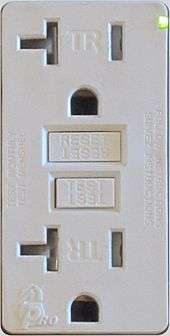
These versions of the 5-15R or 5-20R receptacle are residual-current devices and have Test and Reset buttons (and sometimes an indicator light which may be normally on or normally off per the vendor's design). In the US and Canada, GFCI protection is required for receptacles in many potentially wet locations, including outside outlets, bathrooms, some places in kitchens, basements, and crawl spaces. This is an expedient way to provide that protection at the receptacle itself.[23] They work by comparing the current flowing between the live and neutral conductors, and disconnect the circuit if the difference exceeds 4-6 milliamperes. A single receptacle is cheaper than provding this GFCI protection at the circuit breaker. Like most GFCI devices, a GFCI receptacle can be wired to feed additional "downstream" outlets: putting one GFCI receptacle in a circuit protects all the plugs, lights, and switches downstream from it. These allow for cost-effective retrofits on older installations where branch circuits tended to be daisy-chained between wet and dry locations. They are also recommended for power tool outlets and locations where children might insert conductive objects into the receptacles[23], although this does not replace the requirements for tamper-resistant receptacles.
Tamper-resistant receptacles
Starting with the 2008 National Electrical Code[24] and the 2009 Canadian Electrical Code,[25] listed tamper-resistant receptacles that address electric shock hazards to children must now be installed in almost all areas of new or renovated dwellings. According to statistics cited by the NFPA, the code change adds only $40 to the cost of building an average, 75-receptacle home in the US, yet prevents shock hazards to a child that sticks a single, metal object into the receptacle. The new receptacles are expected to reduce the number of electric shocks to children because inserting a normal, two-blade electrical plug applies pressure on both sides of the receptacle to open an internal, spring-loaded shutter, but a foreign object fails to do so and therefore does not make contact with the live electrical contacts.[26] However, the device can still be defeated by inserting two objects simultaneously. Despite its weaknesses, the tamper-resistant receptacle is superior to protective plastic outlet caps which must be individually installed on each receptacle (and are a choking hazard when removed), and to sliding covers that children easily learn to defeat.[24]
AFCI receptacles
The National Electrical Code has been updated for 2014 and it addresses the use of Outlet Branch Circuit (OBC) Arc Fault Circuit Interrupter (AFCI) Receptacles as an alternative to breakers when used for modifications/ extensions, as replacement receptacles or in new construction. AFCI Receptacles work to address the dangers associated with potentially hazardous arcing conditions (parallel arcs and series arcs) by interrupting power to arcing devices, e.g. a damaged appliance cord, that might otherwise not draw enough current to trip the primary circuit protection device. AFCI protection is mandated by the 2014 Code in residential family rooms, dining rooms, living rooms, kitchens, parlors, libraries, dens, bedrooms, laundry rooms, sunrooms, recreation rooms, closets, hallways or similar rooms. They are also required in dormitory units. AFCI receptacles look similar to GFCI receptacles in that they have a TEST and RESET button on the face of the device for localized testing. This saves a homeowner a trip to the breaker panel should the device trip. Unlike AFCI breakers, AFCI receptacles can be used on any wiring system, regardless of the panel. When installed as the first receptacle on a branch circuit, AFCI receptacles provide series arc protection for the entire branch circuit. They also provide parallel arc protection for the branch circuit starting at the AFCI receptacle.
Surge protective receptacles
Surge protective devices are designed to reduce the random energy surges of voltage transients and electrical noise on the power supply line that can damage sensitive electronics such as TVs, computers, and smart appliances. They are available for 120 V, 15/20 A applications, in different form factors such as surge protective receptacles in single, duplex, four-in-one, and six receptacle configurations as well as surge-protective power strips. These devices provide point-of-use protection and are the last line of defense in a whole-house surge protection network.
Weather-resistant receptacles
Weather-resistant (WR) receptacles are made of UV stabilized thermoplastic with high cold impact resistance to withstand the elements. Required by the 2008 National Electrical Code in outdoor damp or wet locations, WR receptacles should be installed in patio, deck, and pool areas. They are available in a variety of models including GFCI and tamper-resistant. For added protection, WR receptacles should be protected by Extra-Duty While In-Use or Weather-Resistant Covers. These covers are ruggedly constructed to seal out moisture (dripping or condensing), dust, debris, and insects, while providing easy access to receptacles to allow homeowners to use power tools, trimmers, sprinkler systems, and pumps with confidence and improved safety.
Leak-current detection and interruption (LCDI) cordsets
Damaged power cords of portable air conditioners cause many electrical fires and about 350 deaths per year. To combat this, each portable air conditioner sold in the United States is now required to have a leakage current detector interrupter (LCDI) or ground-fault circuit interrupter (GFCI) protective device built into its power cord. The device can be integral with the power plug, or a separate module within 12 inches of the plug. An LCDI cord has a fine wire mesh around the conductors, and circuitry to detect current leaking from the conductors to the mesh, which would happen if the cord were damaged or frayed. The plugs are normal NEMA 5-15, 5-20, 6-15, 6-20 or 6-30 plugs, depending on the air conditioner, typically molded-on plugs. The protection device is equipped with "Test" and "Reset" buttons on the housing.
Color code
The color of a device neither identifies its voltage class nor power system. Because the colors are not identified by national standards, the purpose of color-coding a receptacle is set by the building owner. In this case, building owners may select brown, ivory, white, almond, grey, and black receptacles in the 5-15 configuration to blend with the decor of a room.
However, although colors are not standardized by NEMA, some industries utilize colors for certain applications, following de facto standards:
- A receptacle with a green dot is a so-called "hospital grade" device; such devices are tested to survive harder use than wiring devices intended for residential or commercial purposes.
- Per UL Standard ANSI/UL 498, a receptacle (any color) with an orange triangle, is an isolated ground (IG) device, where the grounding pin of the receptacle is connected to ground independently of the frame of the receptacle and wiring outlet box. This is also a requirement of the National Electrical Code (NFPA 70), Article 406. While neither UL nor the CSA require the face of the receptacle to be a specific color, most IG receptacles are orange.[27]
- A blue receptacle may indicate built-in surge suppressors.
- A red receptacle may indicate a special-service outlet such as one connected to an emergency standby power source. The Canadian Electrical Code requires that "essential" receptacles in hospitals, connected to emergency power systems, must be red.[28]
- At least one manufacturer makes a yellow receptacle, which identifies it as corrosion-resistant.
Break-away tabs
Most duplex receptacles have metal tabs connecting the top and bottom receptacles. These tabs are pre-scored so that they can be broken off to allow the top and bottom receptacles to be wired onto separate circuits.[29] This may allow for one switched receptacle for a lamp, or for two separate supply circuits when heavy loads are anticipated. Two branch circuits may optionally share a common neutral wire terminating on duplex receptacles, a condition sometimes referred to as "split-wiring", "split-receptacle",[30] or "half-split".
Neglecting to break off the tabs when replacing a split receptacle can disable a switched outlet, or cause a short circuit, or accidentally parallel two circuits, depending on how the receptacle had been wired.
Related standards
The dimensions and configurations for NEMA connectors are given in ANSI/NEMA standard WD-6.[2] Underwriters Laboratories maintains UL Standard 498,[31] which specifies construction performance (e.g.: durability, electrical safety, and fire-resistance) for NEMA connectors. These additional requirements allow connectors to be manufactured to be compliant with the National Electrical Code. The Defense Logistics Agency and General Services Administration maintain Federal Specification W-C-596[32] and its associated specification sheets. This specification references WD-6 and UL 498, and provides additional durability and electrical safety performance criteria for connectors intended for military use.
See also
- AC power plugs and sockets
- Industrial and multiphase power plugs and sockets § North America, which includes some non-NEMA plugs and sockets used in North America
- IEC 60320, an international standard for power "inlet" connectors on equipment
- Mains electricity by country
References
- CSA Standard C22.2 No. 42-10: General use receptacles, attachment plugs, and similar wiring devices. Mississauga, Ontario: Canadian Standards Association. 2010. p. 1.
- "ANSI/NEMA WD-6 Wiring Devices Dimensional Specifications". Archived from the original on 2012-02-04. Retrieved 2006-07-27.
- https://www.webcitation.org/5nbLseFj6?url=http://www.nfpa.org/itemDetail.asp?categoryID=266&itemID=18935&URL=Research/Charles%20S.%20Morgan%20Library/FAQ/facts%20and%20lore&cookie_test=1
- Electrical Safety | novascotia.ca
- JIS C 8303-1993, Plugs and Receptacles for Domestic and Similar General Use, Japanese Standards Association, 1993
- "Hubbell catalog, NEMA 2" (PDF).
- NEMA Locking Configuration Chart
- Pull the Plug on Cord-Related Hazards this Holiday Season, retrieved 20 May 2017
- Tamper-Resistant Receptacles — A Successful Adoption (PDF), archived from the original (PDF) on 2 December 2013, retrieved 19 November 2013
- Child outlet safety, archived from the original on 22 January 2009, retrieved 21 January 2009
- Drew Campbell Technical Film and Tv for Nontechnical People, Skyhorse Publishing Inc., 2002 ISBN 1581159986 Chapter 9
- Campbell, Drew (2002). Technical Film and TV for Nontechnical People. Allworth. p. 133. ISBN 1-58115-229-9. Retrieved 2010-02-16.
- Box, Harry C. (2003). Set Lighting Technician's Handbook: Film Lighting Equipment, Practice, and Electrical Distribution (3rd ed.). Focal. p. 20. ISBN 0-240-80495-3. Retrieved 2010-02-16.
- "IEC 60906-2:2011 IEC Webstore". webstore.iec.ch. Retrieved 2016-04-13.
- "www.lincolnelectric.com" (PDF). AC225. Lincoln Electric. Retrieved 25 November 2019.
- Receptacle Roundup IV: NEMA 10-30 and 14-30
- "TeslaMotors.com: Go Electric - Ready, Set, Charge". Tesla Motors, Inc. Archived from the original on 20 June 2013. Retrieved 7 June 2013.
- Hubbell Corporate History
- Hubbell Corporate History Archived February 14, 2010, at the Wayback Machine
- Hubbell Twist-Lock Wiring Devices and Safety Enclosures
- "Industrial grade 15A midget type locking devices" (PDF). cooperindustries.com. Retrieved 2019-05-11.
- "Tamper Resistant Receptacles: The New Standard of Electrical Safety" (PDF). Hubbell Wiring Systems. Archived from the original (PDF) on 12 July 2011. Retrieved 18 October 2009.
- "GFCIs Fact Sheet" (PDF). US Consumer Product Safety Commission. Archived from the original (PDF) on 2010-12-15. Retrieved 2010-05-04.
- "Tamper-Resistant Electrical Receptacles" (PDF). National Fire Protection Association. Archived from the original (PDF) on 7 December 2008. Retrieved 18 October 2009.
- "Frequently Asked Questions". Child Safety Outlet. Archived from the original on 25 July 2011. Retrieved 18 October 2009.
- "Hospital Grade Devices: Tamper Resistant Receptacles" (PDF). Pass and Seymour Legrand. Archived from the original (PDF) on 21 February 2007. Retrieved 18 October 2009.http://www.passandseymour.com/pdf/F10.pdf
- NEMA. "Application Guide for Isolated Ground Wiring Devices". www.nema.org. Retrieved 2016-03-26.
- C22.1-15—Canadian Electrical Code, Part I: Safety Standard for Electrical Installations (23rd ed.). Canadian Standards Association. 2015. Rule 24–106(6). ISBN 978-1-77139-718-6.
- Books.Google.com
- Winnipeg.ca
- UL 498 (2010-05-18). "Attachment Plugs and Receptacles". Archived from the original on 2014-07-04. Retrieved 2014-07-06.
- W-C-596 (2014-05-25). "Connector, Electrical, Power, General Specification for". Retrieved 2014-07-06.
External links
| Wikimedia Commons has media related to National Electrical Manufacturers Association standards. |
- NEMA Chart at mahonkin.com
- NEMA Chart at generatorjoe.net